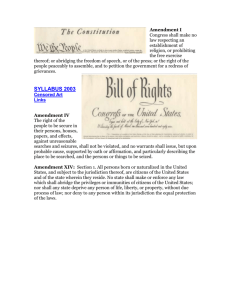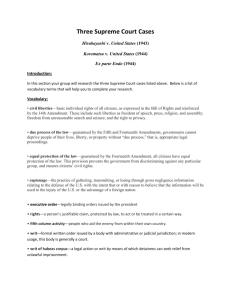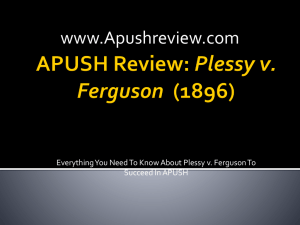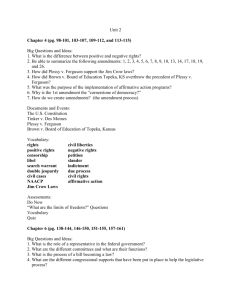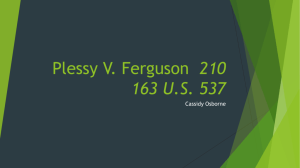Plessy v. Ferguson Student Worksheet
advertisement
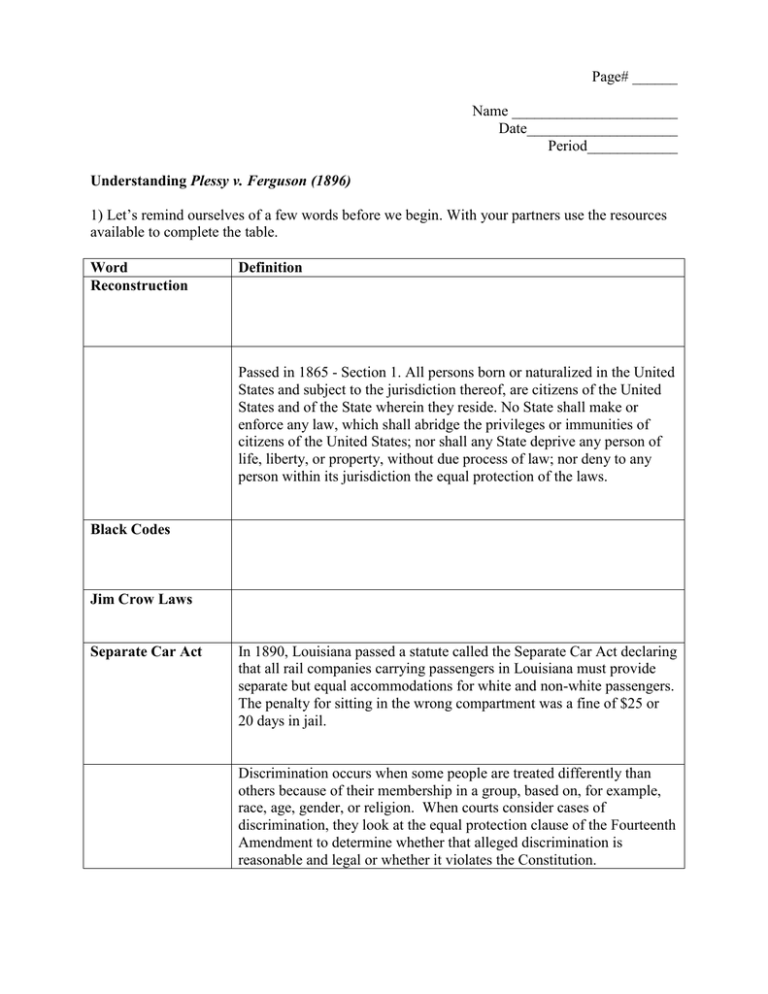
Page# ______ Name ______________________ Date____________________ Period____________ Understanding Plessy v. Ferguson (1896) 1) Let’s remind ourselves of a few words before we begin. With your partners use the resources available to complete the table. Word Reconstruction Definition Passed in 1865 - Section 1. All persons born or naturalized in the United States and subject to the jurisdiction thereof, are citizens of the United States and of the State wherein they reside. No State shall make or enforce any law, which shall abridge the privileges or immunities of citizens of the United States; nor shall any State deprive any person of life, liberty, or property, without due process of law; nor deny to any person within its jurisdiction the equal protection of the laws. Black Codes Jim Crow Laws Separate Car Act In 1890, Louisiana passed a statute called the Separate Car Act declaring that all rail companies carrying passengers in Louisiana must provide separate but equal accommodations for white and non-white passengers. The penalty for sitting in the wrong compartment was a fine of $25 or 20 days in jail. Discrimination occurs when some people are treated differently than others because of their membership in a group, based on, for example, race, age, gender, or religion. When courts consider cases of discrimination, they look at the equal protection clause of the Fourteenth Amendment to determine whether that alleged discrimination is reasonable and legal or whether it violates the Constitution. 2) Directions: Reread the definition of the 14th Amendment. What does the Fourteenth Amendment guarantee to the citizens of every state? ______________________________________________________________________________ ______________________________________________________________________________ ______________________________________________________________________________ ______________________________________________________________________________ 3) -Think, discuss and then write your answers with your group. The 14th Amendment states that citizens should not be denied “equal protection under the law.” Refer to DOCUMENT A. What does the word ”equal” mean to you? Can your group come up with a “legal” definition? ______________________________________________________________________________ ______________________________________________________________________________ Does treating people equally mean treating them the same? Explain. ______________________________________________________________________________ ______________________________________________________________________________ ______________________________________________________________________________ What would it mean to treat people equally in the following situations? Two students try to enter a school that has stairs leading to the entrance. One student is handicapped and the other is not. What would the school have to do to treat these two students equally? ______________________________________________________________________________ ______________________________________________________________________________ ______________________________________________________________________________ ______________________________________________________________________________ Two students live in the same school district. The students are the same age, but they are different races. What does the school district have to do to treat these two students equally? ______________________________________________________________________________ ______________________________________________________________________________ ______________________________________________________________________________ ______________________________________________________________________________ 4) Directions: Read DOCUMENT B in the folder to get an introduction to the events. 5) Directions: In your folder is an article about the background of the case –DOCUMENT CChoose one person to read this passage out loud to the group. 6) The Question: Did the Separate Car Act violate Equal Protection as included in the 14th Amendment? Brainstorm your first thoughts with your group. Write those first ideas in the space below. ______________________________________________________________________________ ______________________________________________________________________________ ______________________________________________________________________________ The Argument before the Supreme Court – The arguments presented to the Supreme Court of the United States in Plessy v. Ferguson involve two competing amendments to the Constitution. The Fourteenth Amendment says states may not deny people equal protection of the law and the Tenth Amendment reserves broad, undefined powers (often referred to as police powers) for the states. Plessy argued that Louisiana’s Separate Car Act violated the 14th Amendment to the U.S. Constitution. It says that states may not “deny to any person within their jurisdiction the equal protection of the laws.” He argued that requiring black people to sit separately from white people implied that blacks were inferior to whites, and therefore unequal. 7) Directions: Pretend you are on the Supreme Court. Look at each of the two Amendments and write how the amendment would apply to Plessy’s situation. If you need more information look in the folder at DOCUMENT K and DOCUMENT L. Fourteenth Amendment - Section 1. All persons born or naturalized in the United States and subject to the jurisdiction thereof, are citizens of the United States and of the State wherein they reside. No State shall make or enforce any law, which shall abridge the privileges or immunities of citizens of the United States; nor shall any State deprive any person of life, liberty, or property, without due process of law; nor deny to any person within its jurisdiction the equal protection of the laws. ______________________________________________________________________________ ______________________________________________________________________________ ______________________________________________________________________________ Tenth Amendment- The powers not delegated to the United States by the Constitution, nor prohibited by it to the states, are reserved to the states respectively, or to the people. ______________________________________________________________________________ ______________________________________________________________________________ _____________________________________________________________________________ 8) Read and think about the effect of the Court’s Decision. Talk with each other about what this decision might mean for African Americans. The Decision- The Supreme Court of the United States determined that if legislation makes distinctions based on race, but does not deprive anyone of rights or privileges, it is constitutional. The Court seemed to believe that the common practice of separation was an inconvenience, not something that reduced the rights of African Americans. The Court also presumed that legislation was powerless to do away with racial instincts or to abolish distinctions based on physical differences. So What? - The Court’s decision set the stage for many more years of discrimination against people of color. Plessy’s case gave rise to a new doctrine: “separate but equal.” States were free to pass laws that kept races separate, and although the facilities were supposed to be equal, they rarely were. The “separate but equal” doctrine would not be abolished until the Civil Rights Act of 1964. Although not specifically written in the decision, Plessy set the precedent that "separate" facilities for blacks and whites were constitutional as long as they were "equal." The "separate but equal" doctrine was quickly extended to cover many areas of public life, such as restaurants, theaters, restrooms, and public schools. 9) Directions: Think about the following situations. Each situation offers separate accommodations for the people involved. Discuss each situation for a few minutes with your classmates. Are these accommodations equal? A black man has been traveling for many hours. He stops at a diner to eat and use the restroom. This diner only serves whites. In order to eat, the black man must travel another two hours to another diner that serves blacks. The black man cannot wait two hours to use the restroom, so he uses the diner's restroom despite the posted signs. A white man is not allowed to have his colored attendant with him in the same train coach even though the white man's health condition requires constant supervision. The colored attendant ignores the rules and sits beside his employer in the coach for white passengers. A black seven-year-old girl must walk two miles to the nearest school for blacks even though there is a school two blocks away. The school two blocks away is only for white students. The girl's parents worry about their daughter walking such a long distance to and from school everyday. 10) Discuss and Answer: What would be the long-term effects of the Supreme Courts decision in Plessy v. Ferguson? How would this decision affect African Americans? How might it affect other people of color? Look at DOCUMENT M as well. ______________________________________________________________________________ ______________________________________________________________________________ ______________________________________________________________________________ ______________________________________________________________________________ ______________________________________________________________________________
